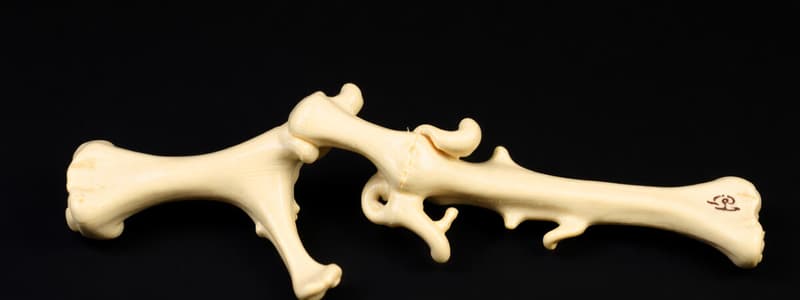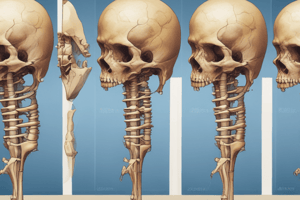Podcast
Questions and Answers
Which of the following factors can delay bone healing?
Which of the following factors can delay bone healing?
- Pain management
- Appropriate movement under medical supervision
- Limited movement
- Poor blood supply (correct)
What is the main function of sesamoid bones?
What is the main function of sesamoid bones?
- To protect the spinal cord
- To form the primary callus during bone healing
- To provide support and flexibility for the body
- To reduce friction and modify pressure in tendons during movement (correct)
Which of these is NOT a stage of bone healing?
Which of these is NOT a stage of bone healing?
- Secondary Bony Callus
- Primary Callus Formation
- Bone Resorption (correct)
- Woven Bone Formation
What type of callus forms in the first months after a bone injury?
What type of callus forms in the first months after a bone injury?
Which of the following bone diseases is characterized by a deficiency in vitamin D?
Which of the following bone diseases is characterized by a deficiency in vitamin D?
Which of these is a primary bone cancer?
Which of these is a primary bone cancer?
Which of these bones is classified as an irregular bone?
Which of these bones is classified as an irregular bone?
What type of bone is replaced by lamellar bone during the bone healing process?
What type of bone is replaced by lamellar bone during the bone healing process?
What is the primary role of osteoblasts in bone?
What is the primary role of osteoblasts in bone?
Which type of bone is primarily responsible for protecting internal organs?
Which type of bone is primarily responsible for protecting internal organs?
What component is primarily responsible for making bone strong and hard?
What component is primarily responsible for making bone strong and hard?
Where are sesamoid bones commonly found?
Where are sesamoid bones commonly found?
Which type of ossification occurs when bone forms from mesenchymal tissue?
Which type of ossification occurs when bone forms from mesenchymal tissue?
What type of bone is characterized by having a long shaft and two articular ends?
What type of bone is characterized by having a long shaft and two articular ends?
What is the main function of short bones?
What is the main function of short bones?
At what age does bone formation typically cease in humans?
At what age does bone formation typically cease in humans?
Flashcards
What are Osteoblasts?
What are Osteoblasts?
Bone-forming cells that create the bone matrix.
What are Osteocytes?
What are Osteocytes?
Mature bone cells that maintain the bone matrix and reside in lacunae.
What are Osteoclasts?
What are Osteoclasts?
Large, multinucleated cells that break down and remodel bone.
What is the Bone Matrix?
What is the Bone Matrix?
Signup and view all the flashcards
What are Hydroxyapatite crystals?
What are Hydroxyapatite crystals?
Signup and view all the flashcards
What are Collagen fibers?
What are Collagen fibers?
Signup and view all the flashcards
When does bone formation occur?
When does bone formation occur?
Signup and view all the flashcards
What is Intramembranous Ossification?
What is Intramembranous Ossification?
Signup and view all the flashcards
Sesamoid Bone
Sesamoid Bone
Signup and view all the flashcards
Fibrocartilaginous Callus
Fibrocartilaginous Callus
Signup and view all the flashcards
Woven Bone Formation
Woven Bone Formation
Signup and view all the flashcards
Bony Secondary Callus
Bony Secondary Callus
Signup and view all the flashcards
Osteoporosis
Osteoporosis
Signup and view all the flashcards
Osteomyelitis
Osteomyelitis
Signup and view all the flashcards
Paget's Disease
Paget's Disease
Signup and view all the flashcards
Osteosarcoma
Osteosarcoma
Signup and view all the flashcards
Study Notes
Bone Composition and Development
-
Bone Cells:
- Osteoblasts: Form bone matrix
- Osteocytes: Maintain bone matrix, reside in lacunae
- Osteoclasts: Resorb and remodel bone
-
Bone Matrix:
- Inorganic Components: Hydroxyapatite crystals (calcium phosphate) – provide hardness
- Organic Components: Collagen fibers – provide flexibility and tensile strength
- Water: 20% of bone composition
-
Bone Development:
- Bone formation begins before birth and continues until ~25 years old
- Intramembranous Ossification: Bone from mesenchymal tissue (e.g., flat bones)
- Endochondral Ossification: Bone from cartilage template (e.g., long bones)
Different Types of Bones and Locations
-
Long Bones:
- Structure: Shaft (diaphysis) and two articular ends
- Location: Limbs (e.g., femur, tibia, humerus)
-
Short Bones:
- Structure: Cube-shaped
- Location: Wrist (carpals), ankle (tarsals)
-
Flat Bones:
- Structure: Thin, flat, often curved
- Location: Skull (e.g., parietal, occipital), sternum, ribs
-
Irregular Bones:
- Structure: Irregular shapes
- Location: Spine (vertebrae), pelvis
-
Sesamoid Bones:
- Structure: Embedded in tendons
- Location: Patella (kneecap)
General Functions of Bone Types
-
Long Bones: Provide strength, structure, and mobility; act as levers for movement with muscles
-
Short Bones: Provide stability and limited movement
-
Flat Bones: Protect internal organs, provide broad surfaces for muscle attachments
-
Irregular Bones: Protect spinal cord, provide support and flexibility
-
Sesamoid Bones: Reduce friction and modify pressure in tendons
Bone Healing and Factors
-
Stages of Bone Healing:
- Primary Callus Formation (fibrocartilaginous callus)
- Woven Bone Formation (dead bone replaced by spongy bone)
- Bony Secondary Callus (spongy replaced by lamellar bone)
- Bone Remodeling (regains original shape)
-
Factors Influencing Healing:
- Factors delaying healing: Infection, poor blood supply, tissue fragments, older age, certain medications (e.g., steroids), and poor host immune response.
- Factors improving healing: Limited movement, rest, pain management, proper nutrition, appropriate medical supervision, younger age
Common Bone Diseases
- Fractures: Broken bones (various types)
- Osteoporosis: Reduced bone density and strength
- Osteomyelitis: Bone infection, often bacterial
- Osteitis: Inflammation of bone
- Acromegaly: Excessive growth hormone leading to bone overgrowth
- Fibrous Dysplasia: Abnormal bone growth
- Rickets: Vitamin D deficiency in children causing poor bone formation
- Multiple Myeloma: Cancer of plasma cells in bone marrow
- Bone Cancer: Cancer affecting bones, sometimes secondary from other organs (e.g., breast, lung, prostate)
Studying That Suits You
Use AI to generate personalized quizzes and flashcards to suit your learning preferences.




